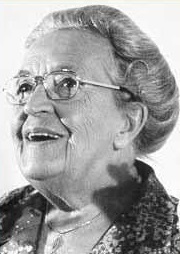
Cornelia Arnolda Johanna "Corrie" ten Boom was a Dutch watchmaker and later a Christian writer and public speaker, who worked with her father, Casper ten Boom, her sister Betsie ten Boom and other family members to help many Jewish people escape from the Nazis during the Holocaust in World War II by hiding them in her home. They were caught, and she was arrested and sent to the Ravensbrück concentration camp. Her most famous book, The Hiding Place, is a biography that recounts the story of her family's efforts and how she found and shared hope in God while she was imprisoned at the concentration camp.

Righteous Among the Nations is a title used by the Yad Vashem to describe people who, for various reasons, made an effort to assist victims, including Jews, who were being exterminated by Nazi Germany during the Holocaust. The term originates from the concept of ger toshav, a legal term used to refer to non-Jewish observers of the Seven Laws of Noah.

The Destruction of the European Jews is a 1961 book by historian Raul Hilberg. Hilberg revised his work in 1985, and it appeared in a new three-volume edition. It is largely held to be the first comprehensive historical study of the Holocaust. According to Holocaust historian, Michael R. Marrus, until the book appeared, little information about the genocide of the Jews by Nazi Germany had "reached the wider public" in both the West and the East, and even in pertinent scholarly studies it was "scarcely mentioned or only mentioned in passing as one more atrocity in a particularly cruel war".
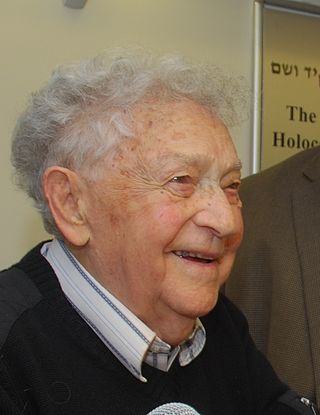
Yitzhak Arad was an Israeli historian, author, IDF brigadier general and Soviet partisan. He also served as Yad Vashem's director from 1972 to 1993, and specialised in the history of the Holocaust.

Plungė is a city in Lithuania with 17,252 inhabitants. Plungė is known for Plungė Manor and its park, where the Samogitian Art Museum is located. In the Oginskiai manor park stands the Perkūnas oak natural monument. The Lourdes of Plungė was created in 1905 and attracts visitors to this day. In the center of Plungė stands a monument for the 10th anniversary of regaining the independence of Lithuania and a sculpture of Saint Florian built by the Lithuanian book carrier Kazys Barzdys.

The Schindlerjuden, literally translated from German as "Schindler Jews", were a group of roughly 1,200 Jews saved by Oskar Schindler during the Holocaust. They survived the years of the Nazi regime primarily through the intervention of Schindler, who afforded them protected status as industrial workers at his enamelware factory in Kraków, capital of the General Government, and after 1944, in an armaments factory in occupied Czechoslovakia. There, they avoided being sent to death camps and survived the genocide. Schindler expended his personal fortune made as an industrialist to save the Schindlerjuden.

Irene Gut Opdyke was a Polish nurse who gained international recognition for aiding Polish Jews persecuted by Nazi Germany during World War II. She was honored as a Righteous Among the Nations by Yad Vashem for risking her life to save twelve Jews.
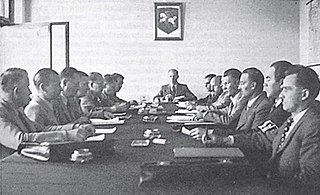
The Provisional Government of Lithuania was an attempted provisional government to form an independent Lithuanian state in the last days of the first Soviet occupation and the first weeks of the German occupation of Lithuania during World War II in 1941.

Papilė is a town in Šiauliai County, Lithuania, near the river Venta.

The Holocaust in Lithuania resulted in the near total eradication of Lithuanian (Litvaks) and Polish Jews[a] in Generalbezirk Litauen of the Reichskommissariat Ostland in the Nazi-controlled Lithuania. Of approximately 208,000–210,000 Jews at the time of the Nazi invasion, an estimated 190,000 to 195,000 were killed before the end of World War II, most of them between June and December 1941. More than 95% of Lithuania's Jewish population was murdered over the three-year German occupation, a more complete destruction than befell any other country in the Holocaust. Historians attribute this to the massive collaboration in the genocide by the non-Jewish local paramilitaries, though the reasons for this collaboration are still debated. The Holocaust resulted in the largest loss of life in so short a period of time in the history of Lithuania.

The Genocide and Resistance Research Centre of Lithuania is a state-funded research institute in Lithuania dedicated to "the study of genocide, crimes against humanity, and war crimes in Lithuania; the study of the persecution of local residents by occupying regimes; the study of armed and unarmed resistance to occupying regimes; the initiation of the legal evaluation of the activities of the organisers and implementers of genocide; and the commemoration of freedom fighters and genocide victims." The centre was founded on 25 October 1992 by the Supreme Council of the Lithuanian Republic as the "State Genocide Research Centre of Lithuania". It is a member organisation of the Platform of European Memory and Conscience.

Amon Leopold Göth was an Austrian SS functionary and war criminal. He served as the commandant of the Kraków-Płaszów concentration camp in Płaszów in German-occupied Poland for most of the camp's existence during World War II.
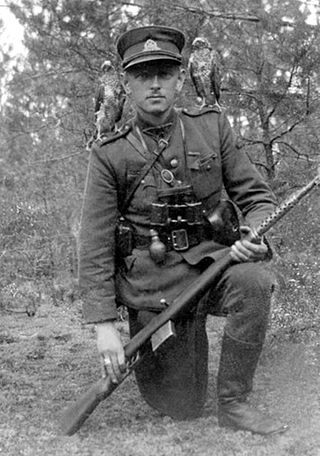
Adolfas Ramanauskas, code name Vanagas, was a prominent Lithuanian partisan and one of the leaders of the Lithuanian resistance. Ramanauskas was working as a teacher under the Nazi administration when Lithuania was re-occupied by the Soviet Union in 1944–45. He joined the anti-Soviet resistance after being pressured by the NKVD to spy on his students, eventually advancing from a platoon commander to the chairman of the Union of Lithuanian Freedom Fighters. Betrayed by a classmate, he was arrested, brutally tortured, and eventually executed. He was the last known partisan commander to be captured.
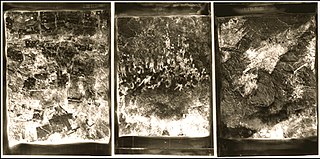
Silvia A. Malagrino is an American multimedia artist, independent filmmaker and educator based in Chicago, Illinois. She is known for interdisciplinary work that explores historical and cultural representation, and the intersections of fact, fiction, memory and subjectivity. Her experimental documentary, Burnt Oranges (2005), interwove personal narrative, witness testimony, interviews, and both documentary and re-created footage to examine the long-term effects of Argentina's Dirty War. Malagrino's art has been featured at The Art Institute of Chicago, Palais de Glace and Centro Cultural Recoleta, La Tertulia Museum, Museum of Contemporary Photography of Columbia College Chicago, Chicago Cultural Center, Rochester Institute of Technology, Center for Photography at Woodstock, and Ateneo de Madrid, among other venues. Her work has been recognized by institutions including the Guggenheim Foundation CINE, the Smithsonian Institution, and Bibliothèque nationale de France. Malagrino is Professor in Photography and Moving Image at the School of Art and Art History of the University of Illinois at Chicago.

Wendy Lower is an American historian and a widely published author on the Holocaust and World War II. Since 2012, she holds the John K. Roth Chair at Claremont McKenna College in Claremont, California, and in 2014 was named the director of the Mgrublian Center for Human Rights at Claremont. As of 2016, she serves as the interim director of the Jack, Joseph and Morton Mandel Center for Advanced Holocaust Studies at the United States Holocaust Memorial Museum in Washington, DC.
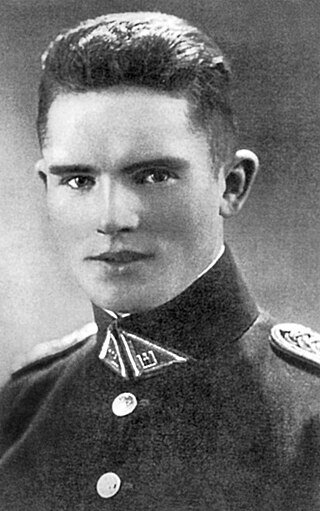
Jonas Noreika, also known by his post-war nom de guerre Generolas Vėtra, was a Lithuanian anti-Soviet partisan, military officer, and Nazi collaborator.

Šukioniai is a village in the southwest of Pakruojis District Municipality, Lithuania. It is located near Vėzgė stream about 12 kilometres (7.5 mi) southwest of Pakruojis.
The Plungė massacre was a World War II massacre committed on 13 or 15 July 1941 in the town of Plungė, in Lithuania. Following the anti-Soviet June Uprising in Lithuania and the German invasion as part of Operation Barbarossa, Plungė was captured by German forces on 25 June 1941. Lithuanian nationalists, led by Jonas Noreika, formed a town administration and police force. German forces killed 60 young Jewish men, accused by the Lithuanians of being a rear guard for the Red Army, shortly after the town's capture. On 13 or 15 July the Lithuanian nationalists transported the Jews to ditches near the village of Kausenai where they were shot. Of the 1,700-1,800 remaining Jews of Plungė, only a few survived.
The Holocaust in Telšiai was carried out by the local Lithuanian leadership with occasional supervision by Nazi German units. The Jewish population in 1939 was 2,800, some 35 percent of the town's population. Additional Jews found refuge in Telšiai following the 1939 German ultimatum to Lithuania. Telšiai was taken by German troops on 25 June 1941. Jews were terrorized by the Germans and their Lithuanian collaborators and on 15–16 July all Jewish men were shot. The women were moved to a camp in Geruliai, and with the exception of 500–600 young women, were all shot on 30 August 1941. The 500–600 young women were moved back to a ghetto in Telšiai, and with the exception of some escapees, were shot on 30–31 December 1941 Of the escapees, 64 Jewish women survived.

The reception of individuals guilty of violations of international criminal law after a conflict differs greatly, ranging from bringing them to justice in war crimes trials to ignoring their crimes or even glorifying them as heroes. Such issues have led to controversies in many countries, including Australia, the United States, Germany, the Baltic states, Japan, and the former Yugoslavia.




















